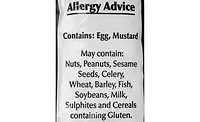TECH FLASH
FSIS announces verification of product formulation and labeling for most common food allergens
Undeclared allergens are the result of a failure in hazard analysis.
USDA’s Food Safety and Inspection Service released a document containing instructions for inspection program personnel (IPP) to make sure facilities are labeling the eight most common food allergens accurately.
The “Big 8,” designated major food allergens by the Food Allergen Labeling and Consumer Protection Act (FALCPA) of 2004, are largely responsible for a sustained increase in the number of recalls of FSIS-regulated products between 2008 and 2012. An FSIS investigation into the rise in undeclared allergen recalls found most issues occurred due to a change in ingredient supplier, products in the wrong package or changes to product or ingredient formulation.
Recognizing this trend, FSIS specifically expanded its verification mandate for IPP to include not just foodborne illness testing but also labeling of all allergenic products. FSIS says the move is necessary to combat the increase in recalls due to undeclared allergens. Big 8 allergens include: wheat, crustacean shellfish, eggs, fish, peanuts, milk, tree nuts and soybeans.
When a product with an undeclared allergen is released into commerce, an establishment has failed to address the chemical food safety hazard in its hazard analysis, failed to support the decisions made in the hazard analysis or failed to effectively implement the necessary controls to support the hazard analysis.
FSIS urges inspection personnel to discuss with operators whether a facility uses any of the Big 8 allergens. If none are in use at the facility, inspection personnel should discuss the importance of identifying allergens before randomly selecting a product produced there and verifying the finished product list of ingredients matches the formulation.
IPP should also ask if the facility has implemented an allergen control plan, if any multi-ingredient compounds used at the facility are manufactured elsewhere, if any products containing allergens had a change in supplier or formulation in the previous six months and where product labels are printed. IPP should verify labeling matches product formulations, as well as inform establishment management of FSIS labeling compliance guides and allergen compliance assistance documents available online.
FSIS also instructed IPP to conduct a “Big 8 Formulation Verification,” where the ingredient formulation of a product containing a Big 8 allergen is verified. If a facility produces multiple products containing different Big 8 allergens, IPP should use a chart outlining priorities in selecting the product for verification.
Top priority goes to a product that had a change in its ingredient supplier in the last six months. Second priority goes to a product with an ingredient that has changed in the last six months. The third priority goes to a product that incorporates a multi-ingredient component produced outside the establishment. If none of the facility’s products meet these criteria, IPP should choose the product produced in the largest quantity at that facility.
IPP should also contact suppliers to confirm “may contain” and “produced in the facility as” statements regarding Big 8 allergens are included on the final label, except when an establishment contacts a supplier for written confirmation such an ingredient is not present in the product and includes a written statement in its hazard analysis explaining why the warning isn’t included on a finished meat or poultry label.
Looking for a reprint of this article?
From high-res PDFs to custom plaques, order your copy today!






